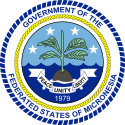 |
|---|
The Constitution of the Federated States of Micronesia is the supreme law of the Federated States of Micronesia. It was adopted in 1979.
History[edit]
Constitutional drafting began in June 1975. It was ratified on October 1, 1978, and took effect on May 10, 1979; May 10 is celebrated as Constitution Day. The constitution has been amended once, in 1990.[1]
Constitution[edit]
The constitution is based on that of the United States, Micronesia's former trustee. It provides for a separation of powers between the executive, legislative, and judicial branches, as well as a federal system.
However, unlike the United States, Micronesia has a unicameral legislature, called the National Congress, with fourteen senators. Four of them represent the four states for four-year terms, and the other ten representatives apportioned by population and serve two-year terms. Also, the National Congress is responsible for electing the President and Vice President.[2] Most government functions other than foreign policy and national defense are carried out by the State governments. The constitution prohibits non-citizens from owning land in FSM.[3]
Articles[edit]
The constitution consists of a preamble, and sixteen articles.
Article I[edit]
Article I defines the territory of the Federated States of Micronesia.
Article II[edit]
Article II ensures the constitution's supremacy over other laws.
Article III[edit]
Article III is the nationality law of the Federated States of Micronesia.
Articles IV, V, and VI[edit]
Articles IV, V, and VI act as the bill of rights for the Federated States of Micronesia, with Article V specifically protecting traditional rights of tribal leaders, and Article VI granting suffrage to those over eighteen years of age.
Articles VII-XI[edit]
Articles VII-XI set out of the government of the Federated States of Micronesia, with a separation of powers among three branches—the executive (Article X), legislative (Article IX), and judicial (article XI). Article VII creates a federal system with a national government, as well as state and local ones. Article VIII separates powers among these three levels.
Article XII[edit]
Article XII concerns government finance.
Article XIII[edit]
Article XIII consists of general provisions.
Article XIV[edit]
Article XIV sets out the process of amending the constitution.
Articles XV and XVI[edit]
Articles XV and XVI are transitional provisions.
References[edit]
- ^ "Micronesia, Federated States of". The World Factbook 2013-14. Washington, D.C.: Central Intelligence Agency. 2014. Retrieved 25 July 2014.
- ^ "Federated States of Micronesia country brief". Australian Department of Foreign Affairs and Trade. March 2014. Archived from the original on 27 July 2014. Retrieved 25 July 2014.
- ^ "Chapter 7: The Federated States of Micronesia". Office of Insular Affairs. U.S. Department of the Interior. Archived from the original on 2 December 2014. Retrieved 30 November 2014.